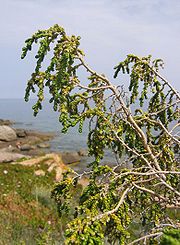Thymelaea
| {{{name}}} Thymelaea
|
'
| ||||||||||||||||||||||||||||||||||||||||
|---|---|---|---|---|---|---|---|---|---|---|---|---|---|---|---|---|---|---|---|---|---|---|---|---|---|---|---|---|---|---|---|---|---|---|---|---|---|---|---|---|---|

|
|
| |||||||||||||||||||||||||||||||||||||||
| |||||||||||||||||||||||||||||||||||||||||
| Standard Cyclopedia of Horticulture |
|---|
|
Thymelaea (Greek, thyme and olive, referring to the thyme-like foliage and the small olive-like fruit). Thymelaeaceae. Hardy or half-hardy perennial herbs, subshrubs or small shrubs, which are very much branched: lvs. sparse, frequently small or narrow: fls. small, sessile and fascicled or solitary at the axils, hermaphrodite or polygamous by abortion; perianth urn-shaped or rarely, especially in male fls., with a slender cylindrical tube; lobes 4, spreading; stamens 8; ovary subsessile, 1-celled: fr. dry.—About 20 species, Medit. region, chiefly, also in Canary Isls.; and in Asia. T. hirsuta, Endl. (Passerina hirsuta, Linn.). Decumbent greenhouse or half-hardy shrub, 1-2 ft. high: sts. slender, fastigiate branched: lvs. coriaceous, ovate, nearly round or oblong, obtuse, 2-3 lines long, glabrous above, white-tomentose beneath: fls. white, in axillary or terminal few-fld. fascicles, which equal the lvs. July. Medit. region. T. Tartonraira, All. (Daphne Tartonraira, Linn. Passerina Tartonraira, Schrad.). Small hardy shrub, wholly silky-canescent, whitish or becoming fulvous: lvs. coriaceous, obovate or obovate- oblong, 5-10 lines long: fls. white, numerous, 2-5-glomerate in the upper axils. June. S. Eu. CH
|
Cultivation
- Do you have cultivation info on this plant? Edit this section!
Propagation
- Do you have propagation info on this plant? Edit this section!
Pests and diseases
- Do you have pest and disease info on this plant? Edit this section!
Species
- Specieswp
Gallery
If you have a photo of this plant, please upload it! Plus, there may be other photos available for you to add.
References
- Standard Cyclopedia of Horticulture, by L. H. Bailey, MacMillan Co., 1963
External links
- w:Thymelaea. Some of the material on this page may be from Wikipedia, under the Creative Commons license.
- Thymelaea QR Code (Size 50, 100, 200, 500)
